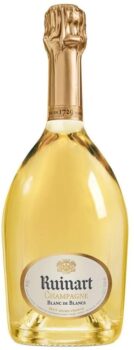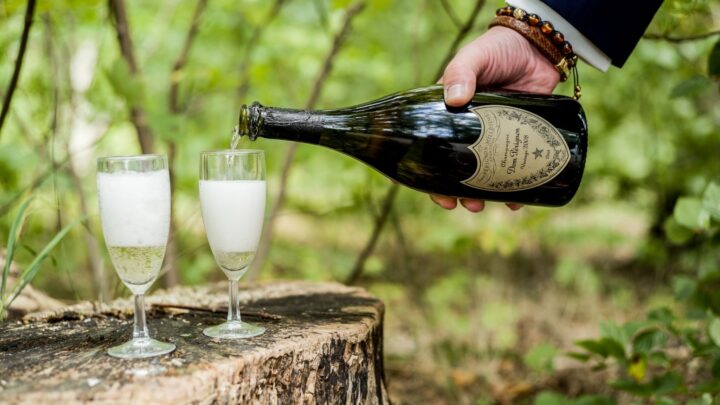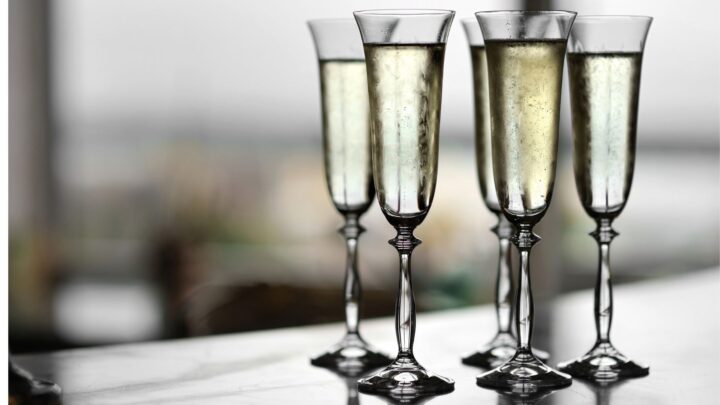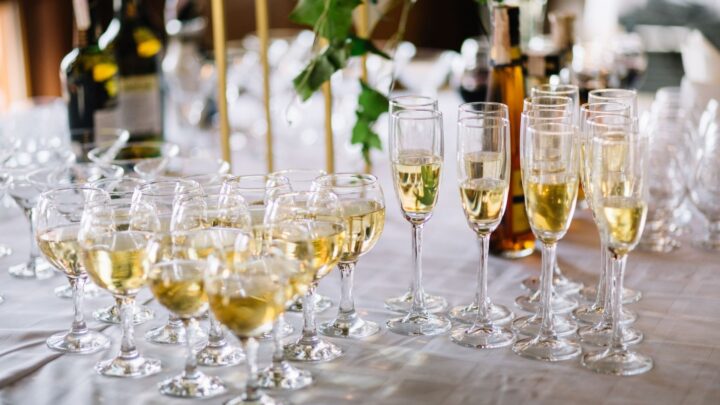Did you know that about 300 million bottles of Champagne are sold every year for a sales value of about 5 billion euros? Champagne is the wine you must have on hand for a celebration, but between the different types of champagnes that exist on the market today, how to choose? Champagne without year, vintage, rosé or crémant or even special vintages, we explain everything in this guide.
Here is our commitment, to make sure that we provide the best user experience and content quality:
You can support us by using our links to make your purchases (at no extra cost to you)! This sometimes earns us a commission which allows us to remain independent. More about us
Our selection
"Created in 1972 to celebrate the bicentennial of the House, La Grande Dame is a tribute to Madame Clicquot. A prestige cuvee from Veuve Clicquot,…"
"This is a champagne from the Pommery vineyard. Its exquisite taste is combined with the finesse of its bubbles and the lightness of its beautiful…"
"Dom Pérignon is only available in vintage champagne and is only produced in exceptional years. Each vintage is a creation, singular and unique. After at…"
"Emblematic of the House, the Blanc de Blancs is the perfect expression of Ruinart's taste and is composed of 100% Chardonnay grapes grown mainly with…"

Created in 1972 to celebrate the bicentennial of the House, La Grande Dame is a tribute to Madame Clicquot. A prestige cuvee from Veuve Clicquot, it is an exclusive blend of eight of their historic Grands Crus.
140 £ on AmazonLa Grande Dame 2008 is a full-bodied blend of eight Grands Crus purchased in the 1800s by Madame Clicquot. The color is a bright, sparkling gold with amber highlights. The initial bouquet is remarkably intense, revealing fruity aromas of peach and bergamot on a mineral background. The bouquet is greedy and voluptuous: a lively and fresh start gives way to rounder aromas of dried figs and apricots, ripe pear and a hint of hazelnut. The long aging on the lees completes the palate with a well-balanced richness and mouthfeel ending with a lively acidity.
On the palate, plenty of body and substance. The texture is crisp and silky. The finish is fresh and generous, a sign of a light dosage that does not disturb the natural balance of the wine. A beautiful wine to offer and for special occasions, it is a perfect aperitif and also goes well with seafood and white meats.

This is a champagne from the Pommery vineyard. Its exquisite taste is combined with the finesse of its bubbles and the lightness of its beautiful foam.
20,72 £ on AmazonDemoiselle Brut Rose is a blend of 85% Chardonnay and 15% Pinot Noir, exclusively from Grands Crus and Premiers Crus. It is a "Tête de Cuvée", which means that only the first part of the juice (the highest quality) has been used. The Rosé "Demoiselle" asserts its personality through its atypical bottle with a careful design. Demoiselle is refined, feminine, elegant and original, the perfect champagne for romantic moments.
You have here a Chardonnay-dominant blend in an "Art Nouveau" shaped bottle. Demoiselle has beautiful bright colors of rose and salmon, a nose dominated by red fruits, raspberries and wild strawberries. This rosé champagne is well balanced, light and lively in the mouth, with a deliciously fruity finish. This wine will go perfectly with fish, seafood and Brie cheese.

Dom Pérignon is only available in vintage champagne and is only produced in exceptional years. Each vintage is a creation, singular and unique. After at least eight years in the cellar, the wine embodies the perfect balance of Dom Pérignon.
392 £ on AmazonThe 2009 vintage of Dom Pérignon is exotic: with a tactile thickness, roundness and depth of flavor that is quite unique. An icon of the house, it has a perfect balance, revealing the harmony so characteristic of Dom Pérignon. In the nose, notes of guava and spicy green grapefruit zest mingle with stone fruits: white peach and nectarine. The whole is enhanced by a woody vanilla and a warm and slightly toasted brioche. In the mouth, the fruit is majestic: ripe, fleshy and deep. Beyond the richness and a certain voluptuousness, it is a strong impression of coherence that prevails. The power of the wine is remarkably contained. The different sensations - silky, salty, sappy, bitter and briny - converge and persist.
Dom Pérignon creates only vintage wines; this is an absolute commitment. Only the best grapes from the most exceptional years are used, making each vintage distinctive. The 2009 vintage will pair perfectly with white meat, fish in sauce and mild cheeses.

Emblematic of the House, the Blanc de Blancs is the perfect expression of Ruinart's taste and is composed of 100% Chardonnay grapes grown mainly with Premiers Crus.
55,60 £ on AmazonThe blend is composed of 100% Chardonnay from several years (including 20 to 25% of wines reserved from the previous 2 years). The Chardonnay grapes are mostly Premiers Crus from the Côte des Blancs and Montagne de Reims vineyards for aromatic refinement, complemented by Sezanese wines known for their maturity. Finally, several wines from the northern part of the Vesle valley bring a light and fresh touch. With a unique aromatic richness, Ruinart Blanc de Blancs has a surprisingly intense and fresh first nose. Notes of lemon and citron blend beautifully with aromas of pineapple and passion fruit underlined by fresh spices like ginger.
Overall, Ruinart Blanc de Blancs is enhanced by subtle, light and invigorating flavors & delicate, airy textures that evoke crispness and tenderness, making it a perfect aperitif champagne. It is an excellent accompaniment to seafood and shellfish; perfect with sea bass or sea bream tartar, or pan-fried sole.
Any specific needs?
The best entry-level champagne
The best alternative champagne
Your guide :
Rate this buying guide :By rating this buying guide, you are helping us to reward our best writers. Thank you!
| TOP OF THE TOP | CHEAP | TOP OF THE LINE | ALTERNATIVE | |

In accordance with our commitment, this buying guide does not contain any sponsored products. |
 9/10 |
 8/10 |
 9/10 |
 9/10 |
| OUR SELECTION |
Veuve Clicquot - La Grande Dame 2008
|
Vranken - Champagne Demoiselle Rosé
|
Dom Pérignon - Magnum vintage 2009
|
Ruinart - Champagne Blanc de Blanc
|
|
Created in 1972 to celebrate the bicentennial of the House, La Grande Dame is a tribute to Madame Clicquot. A prestige cuvee from Veuve Clicquot, it is an exclusive blend of eight of their historic Grands Crus.
|
This is a champagne from the Pommery vineyard. Its exquisite taste is combined with the finesse of its bubbles and the lightness of its beautiful foam.
|
Dom Pérignon is only available in vintage champagne and is only produced in exceptional years. Each vintage is a creation, singular and unique. After at least eight years in the cellar, the wine embodies the perfect balance of Dom Pérignon.
|
Emblematic of the House, the Blanc de Blancs is the perfect expression of Ruinart's taste and is composed of 100% Chardonnay grapes grown mainly with Premiers Crus.
|
|
|
Brand
|
Veuve Clicquot
|
Vranken demoiselle
|
Dom Pérignon
|
Ruinart (Ville de Reims)
|
|
Millimized
|
OUI (2008)
|
NON
|
OUI (2009)
|
NON
|
|
Color
|
Blanc de Noirs
|
Rosé
|
Brut and blanc de blanc
|
Blanc de blancs
|
|
Alcohol content
|
12.5%
|
12%
|
12.5%
|
12.5%
|
|
Allergens
|
Sulfites
|
Sulfites
|
Sulfites
|
Sulfites
|
Help us improve this table:
Report an error, request the addition of a feature to the table, or suggest another product. Thank you for your kindness!
We spend thousands of hours each year studying the major specialized websites, analyzing products of hundreds of brands and reading user feedback to advise you on the best products.
We are a product review company with a single mission: to simplify your buying decisions. Our research and testing helps millions of people every year find the best products for their personal needs and budget.
To support us you can: use our links to make your purchases (which often earns us a small commission), share our articles on social networks, or recommend our site on your blog. Thanks in advance for your support!

While all champagne is sparkling wine, not all sparkling wine is champagne. Champagne refers exclusively to sparkling wine made in the Champagne region of France from traditional champagne grapes. French champagne is also drier than other sparkling wines. Keep this difference in mind when choosing.
The crisp acidity and sparkling character of champagnes make them an ideal accompaniment to a variety of dishes. Depending on the type of grapes used to produce the champagne, each type of champagne has ideal food and wine pairings. For example, Blanc de Blancs, the champagne made from 100% white grapes, goes perfectly with foods such as seafood, vegetarian dishes and creamy cheese. They can also be served at the beginning of a meal as an aperitif.
The aging of champagne is a critical element of production that sets it apart from other sparkling beverages. All champagnes should generally be aged in the bottle for at least 15 months. However, the best producers can age their champagnes for up to 10 years before release. If the champagne is aged longer, it balances the natural acidity and softens the wine, leading to sweeter, more embodied flavors.
Depending on the type of grapes used in production, as well as other factors, champagnes vary in color from white to pink to red. Color can affect the flavor and "heaviness" of the wine in the mouth.
Champagne made from all white grapes is known as "Blanc de Blancs". These wines are generally delicate and have a lighter mouthfeel than those made with the addition of red grapes. They are often served as an aperitif.
"Blanc de Noirs" refers to wines made with black grapes (for example, pinot noir or pinot meunier). These wines are still light in color, but not as white as Blancs de Blancs. Their color can range from straw yellow or golden yellow to light pink, and their flavor is a bit heavier than a Blanc de Blanc.
Rosé wine, which has been gaining popularity lately, is usually dry with a berry aroma and a pink or coral color.
Before you order your champagne online, you need to figure out how much you are willing to spend on champagne. Champagne varies in price. You can get a bottle of champagne for as little as €30 or as much as €300, depending on the quality and brand. So the type of champagne you buy will depend a lot on your budget. If your budget allows, you can opt for a delicious vintage.
It is best to go ahead and drink the bottle as soon as you open it, as champagne tends to flatten out quite quickly after opening. So only open a bottle if you are sure you are going to finish the bottle! If that's not possible, follow these simple tips to extend its shelf life:

A vintage champagne is a champagne that has been aged for at least 3 years. In particular years when the harvest is particularly good, producers make wines from a single vintage. Most opt for a creamy, yeasty style in this aging category.
In contrast, a non-vintage (i.e., unaged or ageless) champagne is aged for only 15 months (minimum). This type of champagne exists so that producers can develop a consistent house style each year (regardless of the quality of that year's harvest). Most unaged champagnes are fruitier than their aged counterparts, and they are a permanent testament to the producer's consistent brand style and quality, the flagship of their expertise.

Blanc de Blancs champagnes are made from 100% white grapes. In Champagne, this means that the wine is 100% Chardonnay. Blancs de Blancs generally have lemon and apple-like fruit flavors. There are of course some rare exceptions to this rule with some very rare grapes (in the same region) including Pinot Blanc, Petite Meslier and Arbane, but for the most part, Blanc de Blancs is 100% Chardonnay.
Blanc de Noirs on the other hand are made exclusively from red grapes, in Champagne this means a combination of Pinot Noir and/or Pinot Meunier only. Blanc de Noirs Champagnes are a rare find. You might expect them to be red in color, but these champagnes are white. The red grapes are lightly pressed so that the pigment is not expelled from the skins. The juice is therefore almost colorless. Blancs de Noirs usually have strawberry and white raspberry flavors.

Rosé champagne is usually made by blending white champagne with a tiny bit of red wine from pinot noir or pinot meunier. The red wine made for champagne is very different from the pinot noir you might think of. Its purpose is to provide pure fruit aromas such as strawberry and raspberry in the taste. The wines are tart, with little tannin and very high acidity.
It doesn't take much red wine to make rosé, and many producers use 10% or less Pinot Noir for their rosé Champagne.
Like all champagnes, brut champagne is made from grapes grown in the northeast of France. Champagne is classified by sweetness. Brut, which means "dry, brut or unrefined," is the driest (i.e., least sweet) classification of champagne. To be considered Brut, Champagne must be made with less than 12 grams of added sugar per liter. Brut Champagne is the most common style of sparkling wine.
Champagne is made using the méthode champenoise, a second fermentation process that occurs inside the bottle after the initial fermentation process. This creates C02 which is captured in the bottle and carbonates the wine. So really, a bottle of champagne is a whole "batch" of sorts.
In terms of grape varieties, only a handful of grapes throughout Champagne are allowed to be used for its base. The only grapes that can be used to produce Champagne are: Pinot Noir (most commonly used), Pinot Meunier (widely used), Chardonnay (widely used), Pinot Blanc, Pinot Gris, Petit Meslier, Arbane.
And as for the taste, champagne has a unique taste dominated by a nutty and toasty flavour. It also has an ultra fine sparkling consistency.
Sparkling wine can also be made using the same method, but another common method is the tank method. This means that the second fermentation cycle is done in a tank and not in individual bottles. Thus, the quality is not as renowned as the real Champagne.
In terms of grape variety, sparkling wine can use any kind of grape variety, including the Californian grape. But common sparkling wines are made from chardonnay and pinot noir grapes. And as for the taste, sparkling wine can vary depending on how they are produced, but mostly fruity with a hint of apple, pear, honey and melon. As for the consistency of the bubbles, they also vary from coarse to fine.
Champagne or sparkling wine, the choice is yours, however if you are rather looking for a wine that is not too expensive, but delicious to share with your family, or with friends at the weekend, look at sparkling wines. However, if you are celebrating a special occasion, choose a good champagne instead: even if it tends to cost a little more than sparkling wine, it really does mark the important events of a life.

To make every special occasion more sparkling
Yes, we love Champagne. It's always nice to hear the sound of a cork popping, to watch champagne being poured into a glass as the bubbles in the liquid seem to make it sparkle with life. We also love the sensation of the bubbles tickling the tongue like little stars exploding on the taste buds.
To make every celebration more festive
Champagne is used in many celebrations, from New Year's Eve to birthdays, Oscar celebrations, weddings and many other special events. Nothing captures the joy and exuberance of a race win like the moment the drivers open their bottles of champagne on the Formula 1 podium.
To get a taste explosion in your mouth
In most cases, champagne is an extremely complex blended wine, not only a blend of sun-ripened grape varieties, but also a blend of aged wines from vineyards throughout the Champagne region. The blend, called the Cuvée, combines the strengths of each vineyard. All wines undergo a traditional second fermentation in the bottle, spending a minimum of three years on the lees (in contact with the yeast), which promotes complex autolytic aromas and a rich mouthfeel.
Champagne is low in calories
Champagne contains fewer calories than red and white wine. A standard glass contains about 80 calories, as opposed to wine, which has about 120 calories. Champagne has about 10 fewer calories per serving than non-sparkling wine and usually comes in a smaller portion, making it a healthier choice.
Champagne can improve your health and longevity
Researchers at Harvard Medical School have found evidence that resveratrol directly activates a protein that promotes health and longevity in animal models. Resveratrol increases the activity of sirtuins (longevity pathways), a group of genes that protect the body against the diseases of aging.
In our opinion, the best brands of Champagnes in 2022 are :
Ruinart is the oldest established Champagne house, producing champagne exclusively since 1729. Founded by Nicolas Ruinart in the city of Reims in the Champagne region of France, this brand is currently one of the most sought-after brands and the most present at parties. The design of its bottle obviously plays for a lot in addition to the taste of the drink. It is a real quality product.
Brut d'argent is one of the most renowned vineyards in the UK. This brand uses exclusively chardonnay to give taste to its wine. The vineyard is located in the Côte de Jura France and has been in operation since 1553. The brand is known for its high quality but reasonably priced products, such as its Brut d'Argent Rosé Pinot Noir.
Veuve Clicquot is a champagne brand created 200 years ago. The brand is known for creating the very first vintage champagne in 1810 with the first mono-millésime champagne. The concept became a huge success the following year, when the iconic 1811 vintage champagne was labelled "The Year of the Comet".
Dom Perignon is owned by Moët & Chandon, although it is considered a separate champagne house. From its traditional antique-style label to its distinct and historic bottle shape, Dom Perignon is a symbol of luxury embedded in popular culture. It stands out from the grand crus because it is never produced in low years, and all the grapes that go into each bottle are always harvested in the same year.
Champagne Pommery is available from The Champagne Company and is located in Reims, France. The Champagne House has been in business since 1836 and works to give luxury and quality products with exceptional taste. Currently, Pommery stands alongside Nicolas Feuillatte for its quality and design.
The diagram below will help you to get an idea of the typical prices for each price range (entry-level, mid-range and high-end).
However, more expensive does not necessarily mean better.
We therefore advise you to always consult our ranking before deciding, rather than blindly relying on price ranges.
Find the right place to store your champagne
The best place to store opened and unopened champagne is in a dark place, out of direct sunlight. This is because sunlight changes the internal temperature of the champagne, which can actually change the chemical composition of the champagne and affect its taste quality.
Place your champagne bottles in a fully enclosed storage area with no exposure to light. If you don't have access to a cellar, a dark closet or cabinet will work. Another alternative is to cover the bottles with a thin dark cloth. A simple shelf will suffice to store your champagne. Your storage solution doesn't need to be pretty or elegant, it just needs to be able to support the weight of your bottles.
Never choose the refrigerator to store champagne
Avoid storing champagne in the refrigerator, both short and long term, unless you are chilling it for serving, as the light from the refrigerator, combined with the refrigerator motor and the temperature fluctuations from constantly opening and closing the door, will ruin the champagne. Champagne is delicate, putting it in the refrigerator could damage its finesse and delicacy.
Be sure to choose the foods you want to serve the champagne with
Campagne is best known to everyone for being served with dessert, yet there are several types of champagnes. The one served with dessert is semi-sweet and mild or fairly mild in taste. Others have a brut or extra brut taste, that is to say, with very pronounced flavors. Also, it is necessary to choose well the foods with which you want to serve your champagne. Here, some suggestions have been given, namely, a champagne a little lively and low in sugar (brut nature or extra brut) is better as an aperitif to awaken your taste buds. What counts at this moment is the freshness of the champagne. But it can also be served with shellfish and raw fish, oysters, smoked salmon, seafood platters, fish tartar, sushi and sashimi, fish terrines. Champagne brut nature or extra-brut will go best with iodized foods. Indeed, sugar does not go well with iodine.
Be clever when you want to refresh your champagne so as not to alter its taste
To ensure that your Champagne is still sparkling the next day, simply leave a spoon hanging in the neck of your bottle of Champagne and place it in the refrigerator. The metal of the spoon makes the neck of the bottle colder, which then creates a plug of cold air over the warmer Champagne.
Avoid mixing champagne and medicine
In fact, even though Champagne seems sweeter and more delicate than other types of alcohol, it is still an alcoholic beverage even at low levels. Also, it is forbidden to drink it while you are on medication. However, if you can limit yourself to 1 or 2 glasses at parties to honor your host, the mixture will not be dangerous. Otherwise, it is better to abstain.
The champagnes are made exclusively in the UK and only in the designated areas of northern France. By law, this is a requirement and if you see champagne from any other country it means that they are not authentic.
The first things to consider when buying champagne is its origin to verify its authenticity or to differentiate it from simple sparkling wine. Then the date of reference of the champagne to determine the quality.
Some researchers have been able to prove that champagne brings several benefits to the person who drinks it. Among these benefits, we can list the simple fact that it can brighten up life or simply that it is synonymous with celebration and that it brings cheerfulness to everyday life.
Well, no. In fact, there are a few types of champagne such as brut, demi-sec, sec, semi-doux, etc. The taste of champagne differs according to each type.
Every month we help more than 1 000 000 people buy better and smarter.
Copyright © 2022 - Made with ♥ by buyingbetter.co.uk
Your reviews and buying guides 0% advertising, 100% independent!